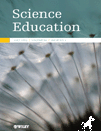
SCIENCE EDUCATION
Scope & Guideline
Transforming Teaching Practices with Rigorous Studies
Introduction
Aims and Scopes
- Interprofessional Education (IPE):
The journal emphasizes the importance of interprofessional education, exploring how collaborative learning experiences among health professions can enhance teamwork and improve patient care. - Assessment Practices:
Research on innovative assessment methods, including Objective Structured Clinical Examinations (OSCEs), peer assessments, and feedback mechanisms to evaluate student competencies and readiness for practice. - Cultural Competence and Diversity:
A strong focus on cultural competence in health education, addressing systemic inequities, and the need for curricula that reflect diverse patient populations and their unique health needs. - Student Well-being and Professional Identity Formation:
Exploration of factors influencing the well-being of students and the development of their professional identities, including the impact of stress, resilience, and social dynamics in educational settings. - Use of Technology in Education:
Investigating the integration of technology in health professions education, including the use of virtual patients, online learning platforms, and gamification to enhance learning outcomes. - Research Methodologies in Health Education:
Promoting rigorous research methodologies, including qualitative, quantitative, and mixed methods approaches, to inform educational practices and policy-making in health professions.
Trending and Emerging
- Mental Health and Well-being in Education:
An emerging focus on the mental health and well-being of students, exploring how educational environments can support resilience and coping strategies in high-stress contexts. - Equity, Diversity, and Inclusion (EDI):
An increasing emphasis on EDI in health professions education, with research addressing systemic barriers and proposing interventions to create more inclusive educational environments. - Competency-Based Medical Education (CBME):
A trend towards competency-based education frameworks that emphasize the development of specific skills and competencies tailored to the needs of healthcare systems and patients. - Technology-Enhanced Learning:
Growing interest in the application of technology in education, including the use of virtual simulations, online learning platforms, and artificial intelligence to enhance educational outcomes. - Community Engagement and Service Learning:
Emerging research on the role of community engagement and service learning in shaping the educational experiences of health professionals, emphasizing the importance of real-world applications. - Interdisciplinary Collaboration:
A trend towards interdisciplinary approaches in health professions education, fostering collaboration among various fields to address complex health issues and improve educational practices.
Declining or Waning
- Traditional Lecture-Based Learning:
There is a noticeable decline in studies focused on traditional lecture-based teaching methods, as the field increasingly emphasizes active learning and student-centered approaches. - Basic Science Knowledge Efficacy:
Research exploring the direct correlation between basic science knowledge and clinical practice outcomes is becoming less frequent, possibly due to a growing focus on integrated and competency-based curricula. - Static Competency Frameworks:
The use of rigid, static competency frameworks is waning, with a shift towards more dynamic and adaptable frameworks that consider evolving healthcare needs and contexts. - Siloed Health Education Disciplines:
There is a reduction in research that treats health professions education in isolation from other disciplines, highlighting a move towards more integrated, interdisciplinary approaches. - Standardized Testing Models:
Research centered on standardized testing as the primary measure of student success is decreasing, reflecting a broader critique of high-stakes testing in favor of holistic assessment methods.
Similar Journals

MEDICAL EDUCATION
Elevating Standards in Medical Education ExcellenceMEDICAL EDUCATION, published by Wiley, stands as a leading journal in the fields of education and medical training, holding a prestigious Q1 ranking in both the Education and Medicine (miscellaneous) categories for 2023. With an impressive impact illustrated by its 94th percentile ranking in Social Sciences Education, this journal has been pivotal in advancing research and discourse since its inception in 1966. Dedicated to enhancing the quality of medical education through scholarly articles, innovative methodologies, and evidence-based practices, MEDICAL EDUCATION provides a vital platform for educators, researchers, and practitioners. Although it does not offer open access, its comprehensive reviews and studies are invaluable resources for those committed to developing effective educational practices in the medical field. This journal is instrumental in shaping the future of healthcare education and fostering knowledge exchange among professionals.

Advances in Medical Education and Practice
Fostering Excellence in Medical Teaching and LearningAdvances in Medical Education and Practice (ISSN: 1179-7258, E-ISSN: 1179-7258) is a prominent open-access journal, published by Dove Medical Press Ltd since 2010, with a specific focus on the evolving landscape of medical education and training. Based in the United Kingdom, this journal aims to disseminate high-quality research and innovative practices that enhance educational strategies in medical and health professions, providing a platform for scholars, educators, and practitioners to share advancements that influence curriculum development, teaching methodologies, and assessment techniques. With impressive rankings in Scopus, positioned in the top quartile of educational journals (Q2 in Education, Rank #517/1543), and a respectable impact in the 66th percentile, it is a vital resource for those invested in enhancing the quality of medical education worldwide. Researchers, professionals, and students will find valuable insights in its comprehensive collection of articles, ensuring they stay at the forefront of advancements in medical education.
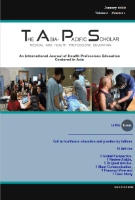
Asia Pacific Scholar
Bridging Scholarship and Practice in Asia Pacific.Asia Pacific Scholar, published by the CENTRE MEDICAL EDUCATION in Singapore, is an esteemed open-access journal that has been contributing to the fields of education and health professions since its inception in 2016. With its ISSN 2424-9335 and E-ISSN 2424-9270, this journal aims to disseminate high-quality research that informs best practices and drives innovation within the academic and medical communities. Currently indexed in Scopus, it holds a Q3 ranking in both Education and Health Professions (miscellaneous) categories and a Q4 ranking in Medicine (miscellaneous), reflecting its commitment to the dissemination of impactful research. The journal incorporates studies, reviews, and reference material that span from 2019 to 2024, fostering a platform for scholars to engage with contemporary issues and advancements in health and educational methodologies. Its open-access model ensures that vital knowledge is accessible to all, enhancing the visibility and reach of research. By bridging the gap between scholarship and practical application, Asia Pacific Scholar plays an essential role in shaping future leaders in education and healthcare.
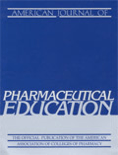
AMERICAN JOURNAL OF PHARMACEUTICAL EDUCATION
Connecting Research and Education in PharmacyThe American Journal of Pharmaceutical Education (ISSN: 0002-9459; E-ISSN: 1553-6467), published by Elsevier, stands as a premier platform in the intersecting fields of pharmacy and education. Established as a vital resource since 1945 and converging through several pivotal periods, this journal has consistently garnered attention for its rigorous selection of research and insight, earning a distinguished ranking in the top quartiles in 2023 across multiple categories, including Q1 in Education, Q1 in Medicine, Q1 in Pharmacology, and Q1 in Pharmacy. Its impact within the academic community is evident, with impressive Scopus rankings placing it among the top in its field (4th out of 45 in Health Professions - Pharmacy). The journal's commitment to advancing pharmaceutical education plays a crucial role in shaping future professionals equipped with the latest knowledge and practices. Although it currently does not offer Open Access options, its rigorous peer-review process and high-impact content ensure visibility and engagement among researchers, educators, and students alike, making it an indispensable resource for those invested in pharmaceutical sciences.

Avances de Investigacion en Educacion Matematica
Driving Progress in Mathematics Education Research and Practice.Avances de Investigacion en Educacion Matematica, published by the SOC ESPANOLA INVESTIGACION & EDUCACION MATEMATICA-SEIM, is a prominent open-access journal dedicated to advancing research and education in the field of mathematics. Since its inception in 2018, this journal has provided a platform for scholars to disseminate innovative findings and pedagogical strategies that enrich mathematical understanding and enhance educational practices. With an impact factor that places it in the Q2 quartile for both Education and Mathematics (Miscellaneous) categories, the journal ranks 179th among General Mathematics publications and 936th in Education, indicating a growing influence within the academic community. Based in Spain, Avances de Investigacion en Educacion Matematica is committed to fostering collaboration and extensive discourse among researchers and educators alike, empowering them to address contemporary challenges in mathematics education. As an open-access journal since 2022, it offers both researchers and practitioners unrestricted access to valuable resources and articles, ensuring that cutting-edge research is widely available to those who shape the future of mathematics education.

Journal of Educational Evaluation for Health Professions
Elevating standards in health professions education.The Journal of Educational Evaluation for Health Professions is a premier Open Access journal that has been dedicated to advancing the field of educational evaluation in health professions since its inception in 2004. Published by the Korea Health Personnel Licensing Examination Institute and based in South Korea, this journal holds prestigious positions in the academic community with a remarkable Q1 ranking in both Education and Health Professions (miscellaneous) categories as of 2023. It specifically serves as a vital platform for researchers, professionals, and students engaged in the assessment and enhancement of educational practices in health care training. The journal is indexed in Scopus with impressive rankings, including the top percentile in Health Professions and Education, underscoring its influence and reach within these critical fields. This journal not only shares innovative research but also aims to foster collaboration and dialogue among educators and policymakers to improve health care education globally.
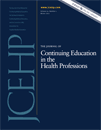
JOURNAL OF CONTINUING EDUCATION IN THE HEALTH PROFESSIONS
Innovating Education for Enhanced Healthcare DeliveryJOURNAL OF CONTINUING EDUCATION IN THE HEALTH PROFESSIONS, published by Lippincott Williams & Wilkins, serves as a pivotal resource in the interrelated fields of education, e-learning, and healthcare. Established in 1988, this esteemed journal aims to advance the knowledge and skills of healthcare professionals through innovative research and practical applications in continuing education. With an ISSN of 0894-1912 and an E-ISSN of 1554-558X, this peer-reviewed publication boasts a commendable reputation, reflected in its Q2 quartile ranking in the categories of Education, E-learning, and Miscellaneous Medicine for 2023. The journal is indexed in Scopus, ranking 546 out of 1543 in Social Sciences Education, placing it in the top 64 percentile. By focusing on the dissemination of impactful studies, the journal plays a critical role in shaping educational strategies that enhance professional development and improve healthcare delivery. Although not an open-access publication, it eagerly invites contributions from researchers and practitioners keen to explore the essential dynamics of continuing education in health professions.

Focus on Health Professional Education-A Multidisciplinary Journal
Bridging Disciplines for Enhanced Health Outcomes.Focus on Health Professional Education - A Multidisciplinary Journal is a pivotal platform in the field of health education, published by the Australian & New Zealand Association of Health Professional Educators (ANZAHPE). This journal serves as a vital resource for educators, practitioners, and researchers dedicated to the advancement of health professional education. With no barriers to access, it promotes knowledge sharing and collaboration across disciplines, making it an excellent venue for innovative research and evidence-based practices in health education. Its diverse scope encourages contributions that foster improved educational strategies, evaluation methodologies, and professional development frameworks. By facilitating dialogue among health professionals, Focus on Health Professional Education significantly impacts the training and quality of care provided by future practitioners, aligning with contemporary trends in healthcare and education. Researchers and professionals can explore the journal's integrative approach to health education, which underscores its commitment to enhancing educational outcomes in an ever-evolving landscape.
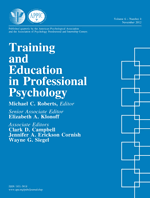
Training and Education in Professional Psychology
Exploring Best Practices in Psychology TrainingTraining and Education in Professional Psychology, published by the Educational Publishing Foundation under the auspices of the American Psychological Association, serves as a vital resource in the realm of psychological education and professional training. Founded in 2007, this esteemed journal has established itself as a premier outlet for innovative research, practical applications, and advancements in psychology education, reflecting its strong standing with a Q2 rating in both Education and Psychology (miscellaneous) categories. With a notable Scopus ranking, placing it in the 75th percentile for Social Sciences - Education and the 66th percentile for General Psychology, it is essential reading for educators, practitioners, and students aiming to deepen their understanding of professional psychologist training and education methodologies. Although the journal is not open access, its contributions to the field are profound, equipping professionals with the insights necessary for fostering the next generation of psychologists.

African Journal of Health Professions Education
Pioneering Research in Health Professions EducationAfrican Journal of Health Professions Education (ISSN: 2078-5127, E-ISSN: 2078-5127), published by HEALTH & MEDICAL PUBLISHING GROUP, is a premier open access journal dedicated to advancing the field of health professions education across Africa and beyond. Launched in 2009, this journal provides a platform for sharing innovative research, pedagogical practices, and policy developments that enhance educational methodologies in healthcare-related disciplines. With its commitment to accessibility, the journal facilitates the dissemination of knowledge to researchers, practitioners, and students alike, thereby contributing significantly to the improvement of health outcomes through effective education. The journal's scope encompasses various areas, including curriculum development, assessment strategies, and the integration of technology in health professions education, making it an invaluable resource for anyone engaged in health education research and practice.